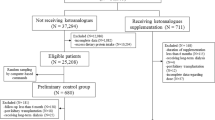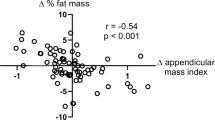Abstract
Residual renal function has been reported to be a major determinant of peritoneal dialysis (PD) technique survival for patients with end-stage kidney disease. Anuria leads to increases in PD prescriptions designed to maintain small solute clearances and ultrafiltration volumes, resulting in greater exposure to hypertonic glucose dialysates. We reviewed the effect of developing anuria in a cohort of 136 PD patients followed for a median of 12 months, to determine whether increasing exposure to higher glucose dialysates affected body composition by increasing body fat and reducing muscle mass. Despite increasing prescription of 22.7 and 38.6 g/l glucose dialysates there was no increase in body fat (31.1±15.4 vs 30.9±16.3 kg) or loss of fat-free weight (36.4±12.1 vs 35.8±12.3 kg). Changing PD prescriptions to maintain small solute clearances and ultrafiltration volumes did not lead to detrimental changes in body composition in the short term.
This is a preview of subscription content, access via your institution
Access options
Subscribe to this journal
Receive 12 print issues and online access
$259.00 per year
only $21.58 per issue
Buy this article
- Purchase on Springer Link
- Instant access to full article PDF
Prices may be subject to local taxes which are calculated during checkout

Similar content being viewed by others
References
Davenport A . Peritonitis remains the major clinical complication of peritoneal dialysis: the London, UK, peritonitis audit 2002-2003. Perit Dial Int 2009; 29: 297–302.
Jager KJ, Merkus MP, Dekker FW, Boeschoten EW, Tijssen JG, Stevens P et al. Mortality and technique failure in patients starting chronic peritoneal dialysis: results of The Netherlands Cooperative Study on the Adequacy of Dialysis. NECOSAD Study Group. Kidney Int 1999; 55: 1476–1485.
Davies SJ, Brown EA, Reigel W, Clutterbuck E, Heimbürger O, Diaz NV et al. What is the link between poor ultrafiltration and increased mortality in anuric patients on automated peritoneal dialysis? Analysis of data from EAPOS. Perit Dial Int 2006; 26: 458–465.
McCafferty K, Fan S, Davenport A . Extracellular volume expansion, measured by multifrequency bioimpedance, does not help preserve residual renal function in peritoneal dialysis patients. Kidney Int 2014; 85: 151–157.
Davenport A, Willicombe M . Comparison of fluid status in patients treated by different modalities of peritoneal dialysis using multi-frequency bioimpedance. Int J Artif Organs 2009; 32: 779–786.
Davenport A, Agarwal B, Wright G, Mantzoukis K, Dimitrova R, Davar J et al. Can non-invasive measurements aid clinical assessment of volume in patients with cirrhosis? World J Hepatol 2013; 5: 433–438.
Davenport A, Willicombe MK . Hydration status does not influence peritoneal equilibration test ultrafiltration volumes. Clin J Am Soc Nephrol 2009; 4: 1207–1212.
Wright M, Woodrow G, O'Brien S, King N, Dye L, Blundell J et al. Disturbed appetite patterns and nutrient intake in peritoneal dialysis patients. Perit Dial Int 2003; 23: 550–556.
Fürstenberg A, Davenport A . Assessment of body composition in peritoneal dialysis patients using bioelectrical impedance and dual-energy x-ray absorptiometry. Am J Nephrol 2011; 33: 150–156.
Mehrotra R . Nutritional issues in peritoneal dialysis patients: how do they differ from that of patients undergoing haemodialysis? J Ren Nutr 2013; 23: 237–240.
Acknowledgements
Dr S Fan has accepted monies from Fresenius AG for speaking engagements, and Fresenius AG have provided educational grants to the Royal London & St Bart’s Department of Renal Medicine, and Fresenius. AG have supported the UCL Centre for Nephrology Dialysis course. This study was funded by the Royal Free Hospital and The Royal London Hospital.
Author information
Authors and Affiliations
Corresponding authors
Ethics declarations
Competing interests
The authors declare no conflict of interest.
Rights and permissions
About this article
Cite this article
Fan, S., Davenport, A. Does increased glucose exposure lead to increased body fat and reduced lean body mass in anuric peritoneal dialysis patients?. Eur J Clin Nutr 68, 1253–1254 (2014). https://doi.org/10.1038/ejcn.2014.119
Received:
Revised:
Accepted:
Published:
Issue Date:
DOI: https://doi.org/10.1038/ejcn.2014.119
This article is cited by
-
Clinical value of body composition monitor to evaluate lean and fat tissue mass in peritoneal dialysis
European Journal of Clinical Nutrition (2019)



